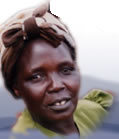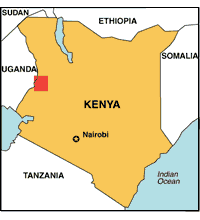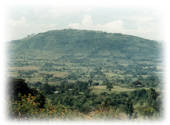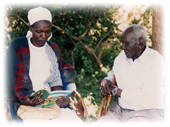 |
 |
||
 |
|||
| LOCAL THEMES agriculture communications conflict culture and customs development education environment family life gender health history identity land livestock politics population social change social relationships spiritual beliefs BACKGROUND
OTHER LOCATIONS |
introducing the area
Overall, some 55 interviews were gathered, of which 23 have been selected for the website. For various reasons, but primarily translation difficulties, the amount of work needed to prepare the remainder of the collection for this site was prohibitive. However, anyone wishing to have access to the other interviews could contact Panos. the themesThere is much less about the environment in these interviews than in other collections, partly because the interviewers did not particularly focus on this topic. But it may also reflect the fact that - given the relative fertility of Mount Elgon - people's concerns were less about productivity or a changing environment, and more about poor access to markets, credit and development facilities. For various reasons, the Saboat feel they have been ignored by successive administrations and have been unable to exploit the area's development potential. There is considerable discussion about the Sabaot's relationships with other groups, especially the Bukusu, and how they believe this relates to a history of oppression and marginalisation. In the early 1990s, these tensions exploded into violence and many families, on both sides, lost their homes and farms. More recently, the government granted the Mount Elgon region its own district status, a move greatly welcomed by the Sabaot, although many still feel that without enough well educated representatives, their physical distance from the heart of Kenya's decisionmaking will be continue to be paralleled by economic and political isolation. Almost all narrators talk of the changes that are affecting their society. Varied experiences and opinions on education, development, changing culture and custom, and relations with other groups and between generations, and men and women, dominate these testimonies. A tension between preserving a strong cultural identity yet being open to learning from others is a common thread. Many recognise that contact with others can bring new ideas, wider experience and positive influences. Yet, perhaps because their relationship with the Bukusu was characterised by oppression, many talk of ridding the area of non-Sabaot, and express distrust and disapproval of outside or modern influences. Finding a balance between preserving the strengths of their old way of life without being excluded from the benefits of modernisation is proving difficult, as it does for many culturally distinct groups. the partners
Using some of the testimonies, KOLA published in 1998 an English language book called "Voices from the Mountain: Personal Life Histories from Mt. Elgon" for national dissemination. IRIS disseminated some of the findings in the national and regional press, producing features based on the interviews and covering topics raised by the narrators, and through a newsletter. Local dissemination has been achieved through presentations at community meetings, at which the interviews and findings were discussed by the contributors and others in the locality, and through two Sabaot language booklets, launched in the community in September 2000. One of these booklets was for adults; the other for children. These are one of the very few resources in their own language available to the Sabaot, thus meeting one of their wishes expressed in the interviews. publications
|
|||||||||

 These
oral testimonies were gathered from the upper and lower slopes in
Mount Elgon district, in Kenya's Western Province. The area is densely
populated and is primarily inhabited by the Sabaot people although
there are also Bukusu, Teso, and a few other tribes, and there has
been a fair degree of intermarriage. The majority of the narrators
in this collection are Sabaot, and therefore the interviews primarily
illustrate Sabaot society, concerns and perspectives. There are
a few Bukusu and Teso narrators. The Sabaot were originally pastoralists
and it is only in the last 50 years or so that agriculture has taken
over from livestock as the main source of income in the area, with
the introduction of cash crops such as maize, beans and coffee.
Most Sabaot live in Mount Elgon district.
These
oral testimonies were gathered from the upper and lower slopes in
Mount Elgon district, in Kenya's Western Province. The area is densely
populated and is primarily inhabited by the Sabaot people although
there are also Bukusu, Teso, and a few other tribes, and there has
been a fair degree of intermarriage. The majority of the narrators
in this collection are Sabaot, and therefore the interviews primarily
illustrate Sabaot society, concerns and perspectives. There are
a few Bukusu and Teso narrators. The Sabaot were originally pastoralists
and it is only in the last 50 years or so that agriculture has taken
over from livestock as the main source of income in the area, with
the introduction of cash crops such as maize, beans and coffee.
Most Sabaot live in Mount Elgon district. This
testimony collection formed part of the "Review of Development
Progress in Kenyan Districts" project planned by the Kenya
Oral Literature Association (KOLA) and Interlink Rural Information
Service (IRIS), a media organisation. The aim was to listen to and
document the views and experiences of ordinary Kenyans on development.
Mount Elgon was one of five districts where testimonies were collected.
KOLA are a literary organisation, primarily documenting oral artistry.
At a workshop in 1996, Panos and KOLA exchanged experiences and
ideas on gathering oral testimony and trained a team of 9 interviewers,
which included several IRIS journalists. It was the first time KOLA
had used this kind of methodology to explore development issues.
Since then they have continued to apply it, and are training other
NGOs to use oral testimony collection as a means of gaining greater
understanding of certain topics.
This
testimony collection formed part of the "Review of Development
Progress in Kenyan Districts" project planned by the Kenya
Oral Literature Association (KOLA) and Interlink Rural Information
Service (IRIS), a media organisation. The aim was to listen to and
document the views and experiences of ordinary Kenyans on development.
Mount Elgon was one of five districts where testimonies were collected.
KOLA are a literary organisation, primarily documenting oral artistry.
At a workshop in 1996, Panos and KOLA exchanged experiences and
ideas on gathering oral testimony and trained a team of 9 interviewers,
which included several IRIS journalists. It was the first time KOLA
had used this kind of methodology to explore development issues.
Since then they have continued to apply it, and are training other
NGOs to use oral testimony collection as a means of gaining greater
understanding of certain topics.
